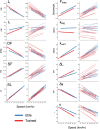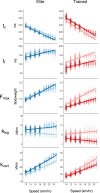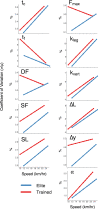Bouncing behavior of sub-four minute milers
- PMID: 34006954
- PMCID: PMC8131362
- DOI: 10.1038/s41598-021-89858-1
Bouncing behavior of sub-four minute milers
Abstract
Elite middle distance runners present as a unique population in which to explore biomechanical phenomena in relation to running speed, as their training and racing spans a broad spectrum of paces. However, there have been no comprehensive investigations of running mechanics across speeds within this population. Here, we used the spring-mass model of running to explore global mechanical behavior across speeds in these runners. Ten elite-level 1500 m and mile runners (mean 1500 m best: 3:37.3 ± 3.6 s; mile: 3:54.6 ± 3.9 s) and ten highly trained 1500 m and mile runners (mean 1500 m best: 4:07.6 ± 3.7 s; mile: 4:27.4 ± 4.1 s) ran on a treadmill at 10 speeds where temporal measures were recorded. Spatiotemporal and spring-mass characteristics and their corresponding variation were calculated within and across speeds. All spatiotemporal measures changed with speed in both groups, but the changes were less substantial in the elites. The elite runners ran with greater approximated vertical forces (+ 0.16 BW) and steeper impact angles (+ 3.1°) across speeds. Moreover, the elites ran with greater leg and vertical stiffnesses (+ 2.1 kN/m and + 3.6 kN/m) across speeds. Neither group changed leg stiffness with increasing speeds, but both groups increased vertical stiffness (1.6 kN/m per km/h), and the elite runners more so (further + 0.4 kN/m per km/h). The elite runners also demonstrated lower variability in their spatiotemporal behavior across speeds. Together, these findings suggested that elite middle distance runners may have distinct global mechanical patterns across running speeds, where they behave as stiffer, less variable spring-mass systems compared to highly trained, but sub-elite counterparts.
Conflict of interest statement
The authors declare no competing interests.
Figures





Similar articles
-
Step frequency patterns of elite ultramarathon runners during a 100-km road race.J Appl Physiol (1985). 2019 Feb 1;126(2):462-468. doi: 10.1152/japplphysiol.00374.2018. Epub 2018 Dec 13. J Appl Physiol (1985). 2019. PMID: 30543498
-
Does running speed affect the performance improvements experienced by elite distance runners wearing advanced footwear technology spikes?J Appl Physiol (1985). 2024 Dec 1;137(6):1690-1698. doi: 10.1152/japplphysiol.00610.2024. Epub 2024 Nov 19. J Appl Physiol (1985). 2024. PMID: 39561014
-
Assessing spring-mass similarity in elite and recreational runners.Front Physiol. 2023 Sep 1;14:1224459. doi: 10.3389/fphys.2023.1224459. eCollection 2023. Front Physiol. 2023. PMID: 37719459 Free PMC article.
-
Biomechanical factors associated with running economy and performance of elite Kenyan distance runners: A systematic review.J Bodyw Mov Ther. 2018 Jan;22(1):1-10. doi: 10.1016/j.jbmt.2017.11.004. Epub 2017 Nov 16. J Bodyw Mov Ther. 2018. PMID: 29332730
-
Training Periodization, Methods, Intensity Distribution, and Volume in Highly Trained and Elite Distance Runners: A Systematic Review.Int J Sports Physiol Perform. 2022 Jun 1;17(6):820-833. doi: 10.1123/ijspp.2021-0435. Epub 2022 Apr 13. Int J Sports Physiol Perform. 2022. PMID: 35418513
Cited by
-
Biomechanics of World-Class 800 m Women at the 2017 IAAF World Championships.Front Sports Act Living. 2022 Apr 14;4:834813. doi: 10.3389/fspor.2022.834813. eCollection 2022. Front Sports Act Living. 2022. PMID: 35498532 Free PMC article.
-
A hierarchical clustering approach for examining potential risk factors for bone stress injury in runners.J Biomech. 2022 Aug;141:111136. doi: 10.1016/j.jbiomech.2022.111136. Epub 2022 May 13. J Biomech. 2022. PMID: 35816783 Free PMC article.
-
Biomechanical, physiological and anthropometrical predictors of performance in recreational runners.PeerJ. 2024 Feb 26;12:e16940. doi: 10.7717/peerj.16940. eCollection 2024. PeerJ. 2024. PMID: 38426136 Free PMC article.
-
Grizzlies and gazelles: Duty factor is an effective measure for categorizing running style in English Premier League soccer players.Front Sports Act Living. 2022 Aug 9;4:939676. doi: 10.3389/fspor.2022.939676. eCollection 2022. Front Sports Act Living. 2022. PMID: 36016922 Free PMC article.
-
Instrumenting Parkrun: Usefulness and Validity of Inertial Sensors.Sensors (Basel). 2024 Dec 24;25(1):30. doi: 10.3390/s25010030. Sensors (Basel). 2024. PMID: 39796819 Free PMC article.
References
-
- Sargent RM. The relation between oxygen requirement and speed in running. Proc. R. Soc. B Biol. Sci. 1926;100(700):10–22.
-
- Sandford G. Applications of the Anaerobic Speed Reserve to Elite 800m Running. Auckland University of Technology; 2018.
MeSH terms
LinkOut - more resources
Full Text Sources
Other Literature Sources
Miscellaneous

